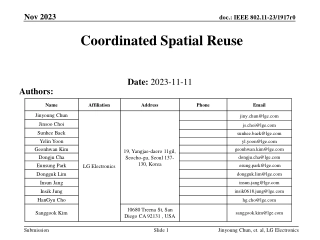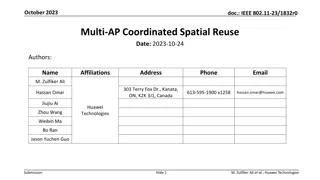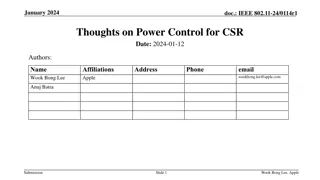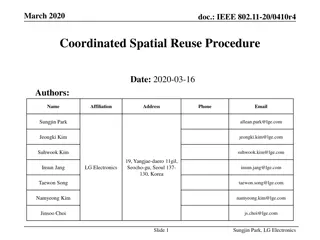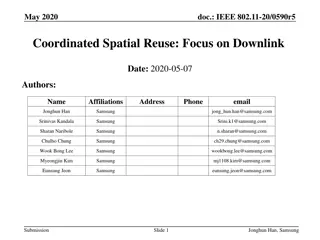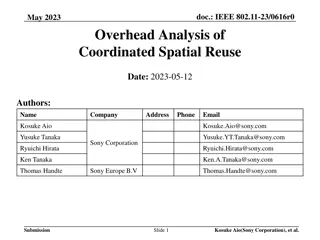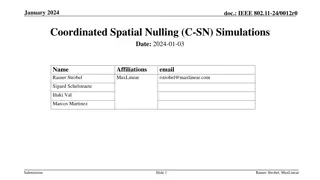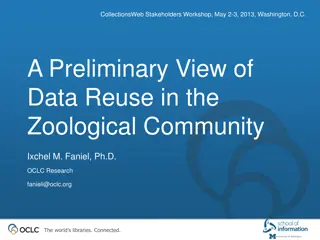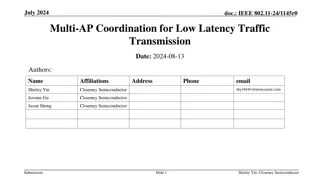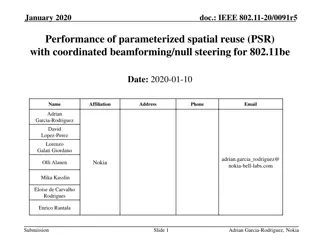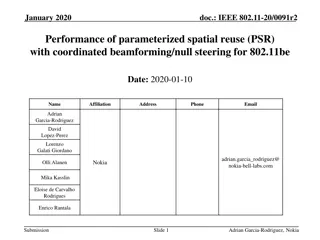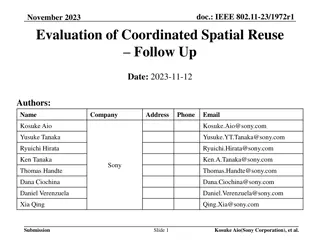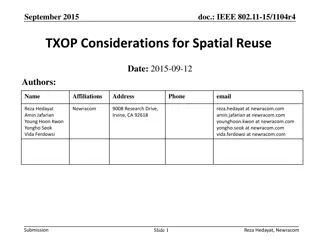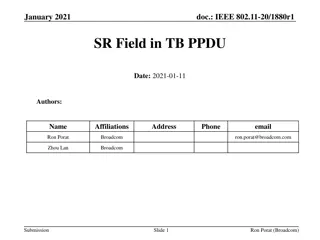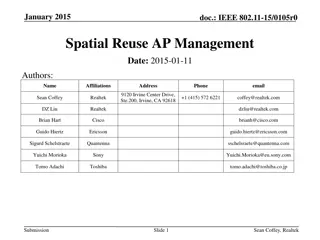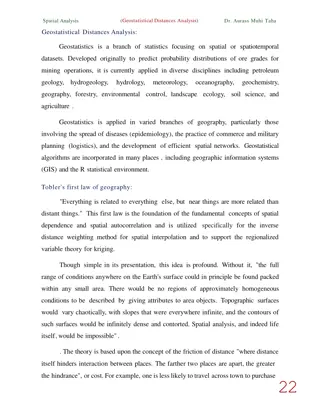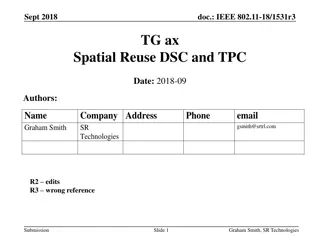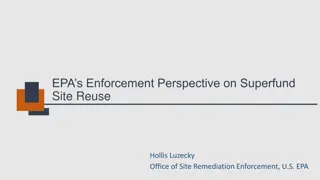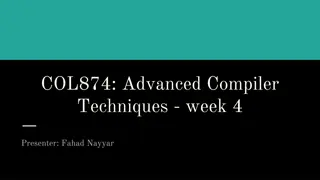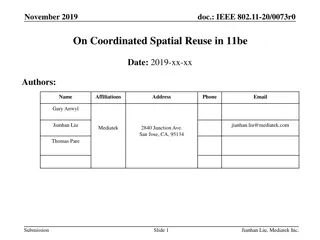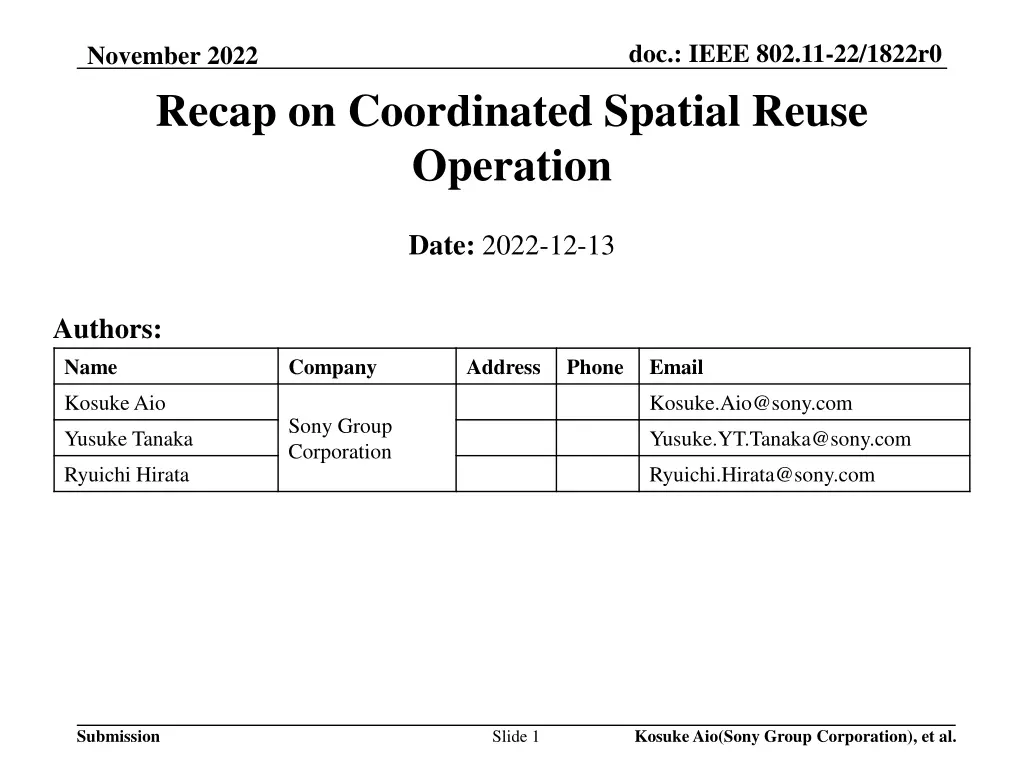
Efficient Multi-AP Coordination for Enhanced Wireless Networking
Explore the innovative Coordinated Spatial Reuse (Co-SR) operation in IEEE 802.11-22/1822r0 standard for improved area throughput and reduced queuing delay. This presentation by Kosuke Aio and team from Sony Group Corporation delves into the benefits and operations of Co-SR, highlighting its simplicity, high throughput gains, and low latency achievement compared to other coordination schemes. Discover how Co-SR allows parallel transmission for multiple APs, enhances SINR at STAs, and minimizes interference through cooperative Tx power control. Dive into the world of advanced wireless technology and its potential for next-generation wireless networking.
Uploaded on | 0 Views
Download Presentation

Please find below an Image/Link to download the presentation.
The content on the website is provided AS IS for your information and personal use only. It may not be sold, licensed, or shared on other websites without obtaining consent from the author. If you encounter any issues during the download, it is possible that the publisher has removed the file from their server.
You are allowed to download the files provided on this website for personal or commercial use, subject to the condition that they are used lawfully. All files are the property of their respective owners.
The content on the website is provided AS IS for your information and personal use only. It may not be sold, licensed, or shared on other websites without obtaining consent from the author.
E N D
Presentation Transcript
doc.: IEEE 802.11-22/1822r0 November 2022 Recap on Coordinated Spatial Reuse Operation Date: 2022-12-13 Authors: Name Company Address Phone Email Kosuke Aio Kosuke.Aio@sony.com Sony Group Corporation Yusuke Tanaka Yusuke.YT.Tanaka@sony.com Ryuichi Hirata Ryuichi.Hirata@sony.com Submission Kosuke Aio(Sony Group Corporation), et al. Slide 1
doc.: IEEE 802.11-22/1822r0 November 2022 Introduction Multi-AP coordination is a candidate feature for next TG as a technology to realize the several objectives and use cases of UHR [1]. Coordinated Spatial Reuse (Co-SR) is one of Multi-AP coordination schemes for TGbe. Co-SR is a simpler coordination scheme compared to Joint transmission and Coordinated Beamforming (Sync and CSI collection are unnecessary). Contributions presented in TGbe[2-5] showed that Co-SR achieves significant performance improvement, e.g. higher throughput than 11ax SR (OBSS_PD). In this contribution, we consider on the operation of Co-SR and offer a simulation result. Submission Kosuke Aio(Sony Group Corporation), et al. Slide 2
doc.: IEEE 802.11-22/1822r0 November 2022 Recap: Coordinated SR APs control Tx power cooperatively to improve area throughput in every transmission. Co-SR allows parallel transmission for multi-APs. For adequate SINR at all STAs, APs mitigate interference by Tx power controlling. With 11ax SR, which isn t a coordinated way, one AP can transmit data with max Tx power and the other APs should decrease Tx Power. Hence, some STAs will get too low SINR. The Concept of Coordinated SR The Concept of 11ax SR Submission Kosuke Aio(Sony Group Corporation), et al. Slide 3
doc.: IEEE 802.11-22/1822r0 November 2022 Benefits of Co-SR Co-SR can achieve low latency by reducing queuing delay, as with other coordination types. Co-SR can achieve higher throughput gain than Time/Freq Scheduling and Co-OFDMA. Co-SR allows parallel transmission with the same resource for multi-APs. Co-SR can be implemented easier than Co-BF and Joint Tx. Co-SR does not require strict synchronization like Co-BF and Joint Tx. Co-SR requires just low overhead measurement because AP only needs to know RSSI information of interference links. Co-SR can work with just very simple calculation algorism. This presentation recaps on the simple operation of Co-SR. Submission Kosuke Aio(Sony Group Corporation), et al. Slide 4
doc.: IEEE 802.11-22/1822r0 November 2022 Co-SR Operation: Measurement Phase AP can request intra-BSS STAs to measure OBSS signal by Measurement Request/Response . Example Procedure 1. AP sends Measurement Request Element to intra-BSS STAs 2. STA responses Measurement Report Element to the AP Beacon measurement type is used well for RSSI measurement because typically Tx power is static. OBSS STA1 1. Measurement Request STA1 OBSS AP1 AP1 2. Measure OBSS Signal OBSS AP2 3. Measurement Report OBSS STA2 Submission Kosuke Aio(Sony Group Corporation), et al. Slide 5
doc.: IEEE 802.11-22/1822r0 November 2022 Co-SR Operation: Transmission Phase (1/3) 1. Sharing AP performs backoff and obtains TXOP. 2. Sharing AP collects information from Candidate APs. Information is for instance; AIDs of STAs which potential Shared APs intend to transmit data to Target SINR of those STAs Trigger frame DATA Sharing AP time DATA time Candidate AP1 (Shared AP1) DATA Candidate AP2 (Shared AP2) time Submission Kosuke Aio(Sony Group Corporation), et al. Slide 6
doc.: IEEE 802.11-22/1822r0 November 2022 Co-SR Operation: Transmission Phase (2/3) 3. Sharing AP estimates SINR of STA(s) which Sharing AP intends to serve and calculates coordinated Tx power for each AP. Only to satisfy target SINR of the STA(s). Without considering BF of interference (just omni) If AP can calculate more, it may be OK that Sharing AP estimates SINR of all STAs to maximize area throughput. Simulation results are added in Appendix. Submission Kosuke Aio(Sony Group Corporation), et al. Slide 7
doc.: IEEE 802.11-22/1822r0 November 2022 Co-SR Operation: Transmission Phase (3/3) 4. Sharing AP transmits a Trigger frame to Shared APs to allow transmission, where a Trigger frame includes; coordinated Tx power of Shared APs. Tx power of Sharing AP (to be used by Shared APs to set optimal MCS) 5. Sharing AP and Shared APs transmit data SIFS after the Trigger frame. Shared APs can set indicated its coordinated Tx power . Shared APs can set optimal MCS by estimating SINR of the STA with the indicated Tx Power information of all APs. Trigger frame DATA Sharing AP time DATA time Shared AP1 DATA Shared AP2 time Submission Kosuke Aio(Sony Group Corporation), et al. Slide 8 Slide 8
doc.: IEEE 802.11-22/1822r0 November 2022 Performance Analysis: Simulation Setup (1/2) Metrics Sum of throughput of all STAs Considering only data payload. (not including MAC and PHY preamble overhead) Optimal MCS based on theoretical PER and SINR per STA Assumption DL only. Each AP transmits data to one associated-STA. APs obtain TXOP in turn with every probability. Each AP operates Tx Beamforming Perfect measurement of RSSI Submission Kosuke Aio(Sony Group Corporation), et al. Slide 9
doc.: IEEE 802.11-22/1822r0 November 2022 Performance Analysis: Simulation Setup (2/2) Following schemes are compared 1. TDD One AP transmits data with max Tx power. The Shared APs don t transmit data. 2. 11ax SR (OBSS_PD) One AP transmits data with max Tx power. (The AP is selected randomly) The Shared APs transmit data with Tx power calculated by OBSS_PD equation. [6] OBSS_PDmin = -82dBm/20MHz, OBSS_PDmax = -62dBm/20MHz 3. Co-SR Target SINR = 26dB. Submission Kosuke Aio(Sony Group Corporation), et al. Slide 10
doc.: IEEE 802.11-22/1822r0 November 2022 Performance Analysis: Simulation Scenario <Layout of Nodes> Home Mesh Scenario based on [6] Layout 3APs are deployed as shown in the right figure. One STA per room is dropped randomly to be associate with an AP in the same room. Parameter Frequency, Bandwidth 5180MHz, 80MHz Fading Model TGac_D NLOS for all the links Max Tx Power 21dBm per AP Pathloss Model Eq.(1) NF 7dB Shadowing 5dB log-normal for all link Tx/Rx Ant (AP, STA) = (4, 1) PPDU HE PPDU with 0.8us GI Stream 1/STA Eq.(1) : PL(d) = 40.05 + 20*log10(freq/2.4)+ 20*log10(min(Dis, bp)) + (Dis > bp) .* (35*log10(Dis/bp)) + Wn * 10dB ( freq = 5.18GHz, Dis = Tx/Rx distance, bp = 5m, Wn : Num. of wall) Precoding SVD MCS 0 - 11 Submission Kosuke Aio(Sony Group Corporation), et al. Slide 11
doc.: IEEE 802.11-22/1822r0 November 2022 Performance Analysis: Simulation Result Sum of throughput Throughput Gain compared to TDD at cdf=0.9 - ax SR : x1.0 - Co-SR : x2.1 Throughput Gain compared to TDD at cdf=0.5 - ax SR : x1.0 - Co-SR : x1.7 Co-SR can achieve good throughput gain. Even if very simple operation (using only RSSI info, calculate only SINR of STA that Sharing AP intends to serve) Submission Kosuke Aio(Sony Group Corporation), et al. Slide 12
doc.: IEEE 802.11-22/1822r0 November 2022 Further Discussion Items 1. Consideration on measurement accuracy We are assuming perfect measurement of RSSI. However, there are variations in RSSI measurement accuracy among STAs. It may depend on MCS selection algorism. Co-SR must take it into account. 2. RSSI measurement procedure We are assuming beacon measurement as an example of RSSI measurement. However, it will take long time to get OBSS beacon. We should consider how to reduce measurement overhead more. 3. Uplink Co-SR procedure We re assuming only DL case and should consider UL case as well. The procedure is almost the same as DL, but there are some points to note, such as how to send trigger frames from multiple APs simultaneously. Submission Kosuke Aio(Sony Group Corporation), et al. Slide 13
doc.: IEEE 802.11-22/1822r0 November 2022 Summary We reviewed the concept of Coordinated SR (Co-SR) and proposed the very simple operation of Co-SR. Sharing AP measures only RSSI information of interference link. Sharing AP estimates SINR of STA(s) which Sharing AP intends to serve and calculates coordinated Tx power for each AP to satisfy target SINR. We evaluated the proposed operation of Co-SR compared with TDD and 11ax SR and confirmed high throughput gain even if very simple operation. Submission Kosuke Aio(Sony Group Corporation), et al. Slide 14
doc.: IEEE 802.11-22/1822r0 November 2022 Reference [1] Yusuke Tanaka (Sony Group Corporation), Considerations on Multi-AP Coordination, 22/1516r0, September 2022. [2] Kosuke Aio (Sony Corporation), Coordinated Spatial Reuse Performance Analysis, 19/1534r1, September 2019. [3] Kosuke Aio (Sony Corporation), Discussion on Coordinated Spatial Reuse Operation, 20/0457r1, April 2019. [4] Jason Yuchen Guo (Huawei Technologies Co. Ltd.), coordinated spatial reuse operation, 20/0033r1, February 2020. [5] Jianhan Liu (Mediatek Inc.), On Coordinated Spatial Reuse in 11be, 20/0073r0, January 2020. [6] Kosuke Aio (Sony Corporation), Consideration on Multi-AP Home Mesh Scenario, 20/0032r0, January 2020. Submission Kosuke Aio(Sony Group Corporation), et al. Slide 15
doc.: IEEE 802.11-22/1822r0 November 2022 Appendix. Additional Simulation Change only room size Room Size = 5m x 5m Room Size = 10m x 10m Submission Kosuke Aio(Sony Corporation), et al. Slide 20
doc.: IEEE 802.11-22/1822r0 November 2022 Appendix. Additional Simulation Change only room size Room Size = 20m x 20m Room Size = 30m x 30m Submission Kosuke Aio(Sony Corporation), et al. Slide 21
doc.: IEEE 802.11-22/1822r0 November 2022 Appendix. Additional Simulation Change only room size System Throughput at 50%-tile System Throughput at 95%-tile As the room size increases and the SINR begins to vary, ax SR performance improve and the difference with Co-SR narrows. In any case, however, Co-SR is still the best performer. Submission Kosuke Aio(Sony Corporation), et al. Slide 22

